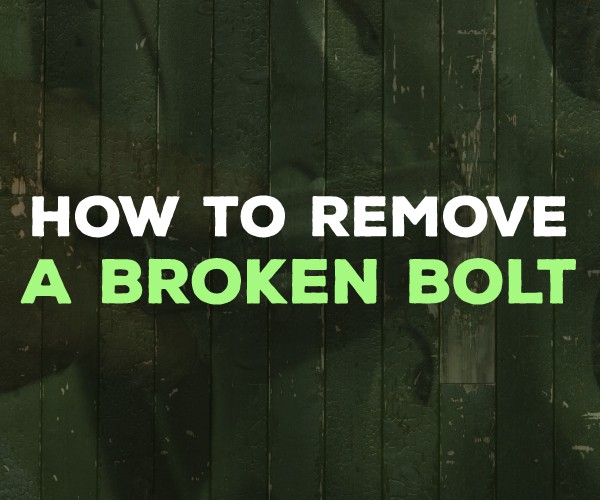Few things are a bigger pain in the rear then breaking off a bolt or screw while you’re in the middle of a project. Not knowing how to remove a broken bolt in these instances can be stressful, and you may be worried about whether or not your project can be salvaged.
Fear not! With the tips found in this guide, you’ll be able to make it over this hurdle in no time so you can get back to finishing your project.
What You’ll Need
When you need to learn how to remove a broken bolt, there are a few different methods you can try. Fortunately, you won’t need an entire toolbox worth of different tools for the extraction, either.
You may not have everything listed below, and if that’s the case, I’d recommend picking up these tools ASAP as this probably won’t be the last time you ever break a bolt.
- Standard ⅜” chuck power drill
- Left-handed drill bit set
- Vise grips
- Center punch
- Hammer
- Bastard cut file
- Easy-Outs
- Compressed air
- Wire brush
- Flashlight
Step I: Assessing the Damage
Before you can remove the damaged bolt, you’ll need to take a closer look at what you’re working with. You’ll probably want to keep a flashlight handy for this portion, especially since Murphy’s Law dictates that the bolt you just broke is probably in a dark and hard to access place.
If you’re lucky, and the bolt or screw snapped with some of the threads still exposed, then your job ahead is a very easy one. But, if you’re not quite as lucky, and there’s nothing left for you to grab onto, you’ll need to reach for a set of Easy-Outs, which are extractor bits that will allow you to remove the headless bolt or screw.
Assuming that the bolt broke with a portion of the threads still exposed, you’ll be able to remove the broken bolt quickly using just a pair of vise grips.
Tighten the thumbwheel of the vise grips to the proper distance (make sure that the grips fit extremely tight on the threads of the bolt) and attach them to the exposed threads. Now, back the bolt out like you would with any other bolt.
If you aren’t that lucky, it’s time to reach for your drill and the Easy-Outs.
Step II: Preparing the Bolt
Before you can get started, you’ll want to file the broken head of the bolt so that it’s completely flat using a bastard file. In some cases, the bolt will break cleanly across the top, and you’ll be able to skip this step.
Once the broken bolt is completely flat, you can tap the bolt.
Step III: Tapping the Bolt
Reach for your center punch, and place it dead center on the broken bolt. Making sure your close to the center will make it much easier for you to remove the bolt, and it will limit the chances of you damaging the internal threads while you work.
Once you’ve found the center, give it a good whack or two with your hammer to mark the center.
Now, put the proper left-handed drill bit into your drill. Your Easy-Out kit should also include a chart that lets you know which drill bit to use based on the size of your broken bolt.
The reason we’re using left-handed drill bits instead of standard ones is that the threads of the drill bit are reversed from standard threads. To drill into the bolt, you’ll actually put the drill in reverse.
This way, the drill bit will torque in the reverse direction of the bolt, so you won’t have to risk driving the bolt even further into whatever it’s attached to.
In some cases, the drill bit will catch on to the broken bolt and begin to back it out for you. At that point, you can grab it with your vise grips and remove it the rest of the way.
Chances are, you’ll need to reach for your Easy-Outs to finish the job.
Step IV: Removing the Broken Bolt
With your pilot hole drilled, all that’s left to do is tap in the appropriately sized Easy-Out and remove the broken bolt.
Take the Easy-Out and place the tapered tip into the hole you’ve drilled. Give it a strong tap or two with your hammer, which will drive the Easy-Out into the broken bolt and allow it to get a good hold on the bolt.
The opposite end of an Easy-Out usually can be attached to a screwdriver handle or torque wrench to give you extra torque when you’re removing your bolt. If you’re unable to unscrew the broken bolt using just your fingers, attaching a screwdriver, T-handle or ratchet will make the job much easier.
Step V: Cleaning Up
There’s a good chance that metal filings have made their way into the hole you just removed the broken bolt from. It’s helpful to blow some compressed air into the hole and hit the threads with a wire brush to make sure everything is nice and clean before replacing the broken bolt.
Wrapping it Up
There are few noises that the experienced home craftsman dreads more than the sound of a bolt snapping off as you’re trying to remove it. Fortunately, learning how to remove a broken bolt is quite easy, and you’ll be able to get the job done with just a few tools, and the tips in this guide.
While you may not have all the tools necessary to get the job done already, they’re worth picking up as quickly as you can, as they’re sure to come in handy with future projects.

